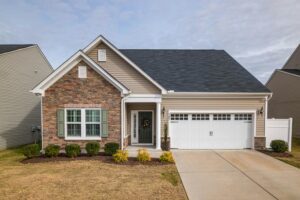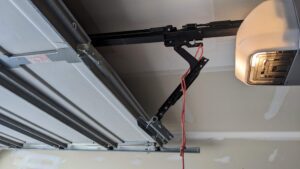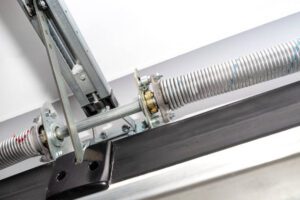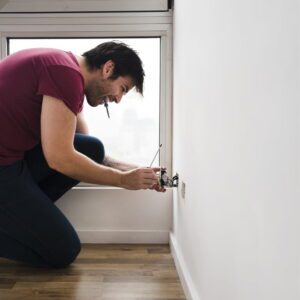Top Indicators Your Garage Door Needs Repair and How to Fix It
 In the complex ecosystem of home maintenance, few components play as pivotal a role as your garage door. Yet, it’s often overlooked until malfunction signs become too apparent to ignore. Understanding how to repair garage door issues not only ensures the safety and security of your home but also can significantly extend the lifespan of the door itself. From the annoying squeak that disrupts the morning calm to the more serious security breach of a door that won’t close, being able to discern and address these problems promptly is crucial. In this context, garage door troubleshooting becomes an essential skill for homeowners, blending the necessity of routine garage door maintenance with the more advanced techniques required for specific repairs.
In the complex ecosystem of home maintenance, few components play as pivotal a role as your garage door. Yet, it’s often overlooked until malfunction signs become too apparent to ignore. Understanding how to repair garage door issues not only ensures the safety and security of your home but also can significantly extend the lifespan of the door itself. From the annoying squeak that disrupts the morning calm to the more serious security breach of a door that won’t close, being able to discern and address these problems promptly is crucial. In this context, garage door troubleshooting becomes an essential skill for homeowners, blending the necessity of routine garage door maintenance with the more advanced techniques required for specific repairs.
This article will navigate you through the critical signs that signify your garage door needs attention — from slow movement and excessive noise that might hint at how to repair garage door cable problems, to more conspicuous issues like door jerkiness, misalignment, or an unresponsive door. Each section is dedicated to identifying a particular problem, understanding its implications, and guiding you through the steps for garage door troubleshooting and repair. Whether it’s adjusting the safety sensors, dealing with broken springs, or understanding how much does it cost to repair garage door components like rollers, torsion springs, or the motor, this guide covers it all. Moreover, the discussion extends to preventive measures like regular lubrication and alignment checks to avoid common problems. By the end, homeowners will be equipped with the knowledge to not only repair their garage door but also ensure it remains in prime working condition for years to come.
Signs Your Garage Door Is Slow
When a garage door begins to operate slower than usual, it can be a sign of several underlying issues that require immediate attention to prevent further damage and ensure efficient operation. Here are some common causes and solutions for a slow-moving garage door:
Causes of Slow Movement
A slow-moving garage door can often be traced back to mechanical issues or incorrect settings. Firstly, it’s essential to inspect the opener’s settings. Many garage door openers have adjustable dials or buttons that control the door’s force and speed. Over time, these settings might be inadvertently changed or decrease due to vibration and regular use, necessitating a readjustment to restore optimal performance.
Additionally, the age of the door’s components can play a significant role. Springs, pulleys, and rollers can wear out or lose tension, reducing the system’s efficiency. It’s also possible that the tracks are misaligned or obstructed, which can significantly hinder the door’s movement.
Lubrication Issues
Proper lubrication is crucial for the smooth operation of a garage door. However, using the wrong type of lubricant can attract dust and debris, which compounds the problem. It’s recommended to use a silicone-based lubricant or white lithium grease, as these materials do not attract dirt and are effective in a wide range of temperatures. Before lubricating, it’s important to clean the tracks and check for any worn parts like hinges and rollers that might need replacement or adjustment.
Programming Check
Lastly, the programming of the garage door opener itself can affect the door’s operation speed. Some modern garage door systems include computerized technology that may require professional recalibration or repair. Additionally, ensuring that the garage door opener is receiving adequate power and that all safety sensors are correctly aligned and unobstructed is vital for proper function.
By addressing these issues—mechanical wear, improper lubrication, and programming anomalies—homeowners can often restore their garage door’s speed and reliability, avoiding the inconvenience and potential hazards of a malfunctioning system.
Recognizing Excessive Noise
Excessive noise from a garage door is not only a nuisance but can also indicate underlying mechanical issues that require immediate attention. Understanding the types of noises and their potential causes can help homeowners diagnose and address problems efficiently.
Types of Noises
Garage doors can emit a variety of sounds that signal different issues. Common noises include grinding, squeaking, rattling, squealing, clanking, and banging. Each sound can point to distinct problems, from worn-out parts to loose hardware. For instance, a grinding noise often suggests issues with the door’s rollers or tracks, while squeaking might indicate dry or insufficiently lubricated hinges.
Potential Issues
The root causes of noisy garage doors are often related to poor lubrication, loose components, or both. Over time, the metal parts of a garage door, such as springs, hinges, and cables, can corrode and rust without regular maintenance, leading to unpleasant noises. Additionally, nuts, bolts, and screws can loosen due to the door’s frequent movements, further contributing to the noise. In some cases, an off-balance door caused by worn springs or a damaged track can produce scraping or banging sounds as it operates.
Immediate Actions
To mitigate these issues, homeowners should first conduct a thorough inspection of their garage door to identify any loose hardware. Using a wrench and socket, one can tighten all visible nuts, bolts, and screws, taking care not to overtighten, which could strip the hardware or create excessive tension. Regular lubrication is crucial; a silicone spray or white lithium grease is recommended for most garage door parts, including roller shafts, hinges, and springs. This not only reduces noise but also prolongs the lifespan of the components.
For persistent or unclear noises, such as those that might indicate an off-balance door or failing motor, professional assessment and repair are advised. Attempting to manually test the balance of a garage door can confirm suspicions of misalignment. If the door does not remain stable when lifted to waist height, this is a clear indication of imbalance that requires professional correction.
By addressing these common auditory signs promptly, homeowners can maintain a quiet, efficient, and safe garage door operation, ensuring peace of mind and the longevity of their garage system.
Door Jerking When Closing
Common Causes
Door jerking when closing is often attributed to several mechanical issues that disrupt smooth operation. One frequent cause is loose screws and bolts in the tracks, which can get caught as the garage door moves, leading to a jerking motion. Additionally, dents or crimps in the door track can severely affect the door’s movement. Damaged rollers, which are crucial for smooth operation, can also lead to jerking if they become loose or worn out. Over time, the rubber seal around the door can accumulate grime and debris, becoming sticky and causing resistance when the door moves.
Inspection Process
To diagnose the cause of door jerking, a thorough inspection is necessary. Homeowners should start by examining the tracks for any loose screws, bolts, or physical damage like dents and crimps. It is also important to check the condition of the rollers to see if they are damaged or require lubrication. The rubber seal around the door should be inspected for stickiness or excessive dirt build-up, which can contribute to jerking.
Parts to Check
During the inspection, several parts should be closely examined:
- Screws and Bolts: Ensure all are tight and secure. Loose hardware can cause the door to jerk due to instability in the track.
- Door Track: Look for any signs of damage or obstruction that could impair smooth sliding.
- Rollers: Damaged or worn rollers need to be replaced or repaired to ensure they glide smoothly along the tracks.
- Rubber Seal: Clean and lubricate the seal to prevent it from sticking and causing resistance.
Addressing these issues typically resolves the jerking problem, enhancing the door’s functionality and safety. Regular maintenance and prompt repairs are crucial to prevent future occurrences and ensure the longevity of the garage door system.
Garage Door Off Track
When a garage door comes off its track, it presents not only a functional issue but also significant safety risks. Addressing this problem swiftly and effectively is crucial to prevent further damage and ensure the safety of everyone around.
Risks Involved
A garage door off its track can lead to severe consequences. The immense weight of the door, often up to two tons, poses a risk of serious injury or even death if the door were to fall. Additionally, an off-track door can cause structural damage to the property and prevent the movement of vehicles in and out of the garage, especially during adverse weather conditions, leading to potential damage to the vehicles themselves.
How to Realign
Realigning a garage door that has come off its track involves several critical steps:
- Safety First: Ensure the garage door is disconnected from the opener and securely braced to prevent it from moving unexpectedly.
- Inspect and Remove Obstructions: Check the tracks for any obstructions like dirt, debris, or damage. Cleaning the tracks and removing any foreign objects is essential for smooth operation.
- Adjust the Tracks and Rollers: If the tracks are bent or misaligned, they need to be straightened and properly aligned. This might require loosening the mounting brackets and gently tapping the tracks back into position.
- Reattach and Test the Door: Once the tracks are aligned, the rollers should be reinserted into the tracks. Test the door manually before reconnecting the opener to ensure it moves smoothly without resistance or noise.
When to Call a Professional
While some adjustments can be made independently, certain conditions necessitate professional intervention:
- Significant Track Damage: If the tracks are severely bent or broken, professional replacement is necessary.
- Spring and Cable Issues: Problems with springs and cables can be dangerous to address without proper tools and expertise. If these components are faulty, it’s safer to contact a professional.
- Persistent Alignment Problems: If the door continues to come off track despite attempts to fix it, this could indicate a more complex underlying issue that requires professional diagnostics and repair.
Regular maintenance, including proper lubrication and checking for loose components, can prevent many issues associated with garage doors going off track. However, in cases of severe or recurrent problems, relying on experienced professionals ensures that the repairs are conducted safely and effectively, safeguarding both the functionality of the door and the safety of its users.
Unbalanced Garage Door
An unbalanced garage door can pose serious risks, not only to the functionality and longevity of the door itself but also to the safety of those who use it regularly. Recognizing the signs of imbalance and understanding how to check and correct it are crucial for maintaining the optimal operation of your garage door system.
Signs of Imbalance
Several indicators suggest that a garage door is unbalanced. If the door appears slanted or hangs unevenly while opening or closing, it likely suffers from balance issues. Unusual sounds such as grinding or squeaking during operation can also signal added strain on the garage door opener. Moreover, if the door takes longer than usual to open or close, or in severe cases, doesn’t open at all, these are strong indications of an imbalance that needs immediate attention.
Step-by-Step Balance Check
To ensure your garage door is properly balanced, follow these steps:
- Close the Door: Start with the garage door closed.
- Disconnect the Opener: Detach the door from the garage door opener by pulling the emergency release handle.
- Manual Operation: Open and close the door manually. It should move smoothly without resistance. If the door sticks or binds, check for obstructions or apply lubrication to necessary components like rollers and hinges.
- Lift and Release: Lift the door about halfway up (3-4 feet off the ground) and then let go. A balanced door will stay in place, slightly moving up or down is acceptable, but it should not slam shut or shoot upward.
- Reattach the Door: If the door operates smoothly and stays in position when released, reattach it to the opener.
Critical Repairs
If during the balance check, the door exhibits signs of severe imbalance, such as slamming shut or shooting upwards, professional intervention is necessary. Imbalances often stem from issues with the springs—either they are not providing sufficient tension or are exerting too much pressure. Adjusting the tension of garage door springs is hazardous and should only be performed by trained professionals. They have the tools and expertise to safely make adjustments and replace worn or broken components.
Regular maintenance checks, including a balance test, should be conducted seasonally to ensure the longevity and safe operation of your garage door. Ignoring signs of imbalance can lead to premature wear and tear on the garage door opener and other critical components, potentially resulting in costly repairs or replacements. Always prioritize safety and efficiency by addressing any signs of an unbalanced garage door promptly.
Garage Door Won’t Open or Close
When a garage door refuses to open or close, it can be frustrating and potentially pose a security risk. Addressing this issue involves several troubleshooting steps, focusing on different components of the garage door system.
Initial Troubleshooting
The first step in resolving a garage door that won’t operate is to check the basics:
- Power Supply: Ensure that the garage door opener is plugged in and that the circuit breaker has not tripped.
- Emergency Release: If the door is stuck, the emergency release cord can be pulled to disengage the opener, allowing manual operation of the door. This can help determine if the issue is with the door itself or the opener.
- Lock Mode: Modern garage door openers have a lock mode that might have been activated accidentally. If the door does not respond to the remote but the wall button works, this might be the issue.
Control Panel Check
The control panel, or wall button, can fail due to wiring issues or system malfunctions:
- Door Control Panel: Inspect the wiring of the door control panel for any loose connections or damage. If the wires are intact, try resetting the control panel.
- Learn Button: Locate the ‘Learn’ button on the garage door opener to reset the system. This might resolve any syncing issues between the remote and the opener.
- Safety Sensors: Check if the LED lights on the safety sensors are blinking, indicating an obstruction or misalignment. Clear any obstacles and ensure the sensors are correctly aligned.
Spring Inspection
Garage door springs are critical for proper operation and can be the culprit when a door won’t open or close:
- Visual Inspection: Look for signs of wear or damage on the torsion springs, which are located above the garage door, or the extension springs, which run along the tracks on either side.
- Balance Test: Disengage the opener and manually lift the door halfway. A well-balanced door should stay in place. If it falls or shoots up, the springs might need adjustment or replacement.
- Professional Assessment: Due to the high tension involved, spring repairs should generally be handled by professionals to avoid injury.
By systematically checking these components, homeowners can often identify the reason their garage door isn’t functioning correctly and decide whether they can fix the issue themselves or need to call a professional. Regular maintenance checks can prevent many of these problems from arising in the first place.
Conclusion
Navigating the nuances of garage door maintenance and repair is crucial for ensuring the longevity, safety, and functionality of one of the most vital yet often overlooked components of your home. From understanding the early signs of wear, such as slow movement and excessive noise, to addressing more evident issues like door jerkiness, misalignment, or complete operational failures, this article has provided homeowners with a foundational guide to troubleshooting and fixing common garage door problems. By following the outlined steps, homeowners not only safeguard their property and loved ones but also potentially avoid the cost and inconvenience of major repairs.
The emphasis on regular checks, proper lubrication, and the importance of professional assessment for more complex issues highlights the balance between DIY maintenance and the need for expert intervention. For those issues that demand a skilled touch, remember that help is just a phone call away. Consider reaching out to Dynamic garage doors at 877-213-9571 for professional advice and service. With the right approach and proper care, your garage door can continue to serve you efficiently and safely for many years to come, maintaining its role as a key component in the day-to-day functionality of your home.
FAQs
1. How can I fix misaligned sensors on my garage door?
To correct misaligned sensors on your garage door, first ensure that the sensors on either side of the door are at the same height and directly facing each other. Clean the lenses with a soft cloth and gently adjust them until the indicator lights show they are properly aligned and functioning.
2. How can I tell if my garage door sensor is malfunctioning?
To test the functionality of your garage door sensor, place a cardboard box in the path of the closing door and use the remote to close the door. If the sensor is in good working order, the door will halt and reverse to its open position upon detecting the box. If the door continues to close and crushes the box, the sensor likely needs repair or replacement.
3. What is a common issue with garage doors?
A frequent issue with garage doors is when they become stuck in the open position. If this occurs, a good starting point for troubleshooting is to inspect the photo eye sensors located on either side of the door to ensure they are clean, aligned, and unobstructed.
4. How do you know when it’s time to replace your garage door?
Signs that your garage door may need replacing include noticeable damage such as dents and dings, deterioration of wooden doors evidenced by cracks, holes, peeling paint, or rot, sagging, excessive noise during operation, and the presence of broken parts such as wires or cords. If you observe these issues, it may be time to consider a replacement.






